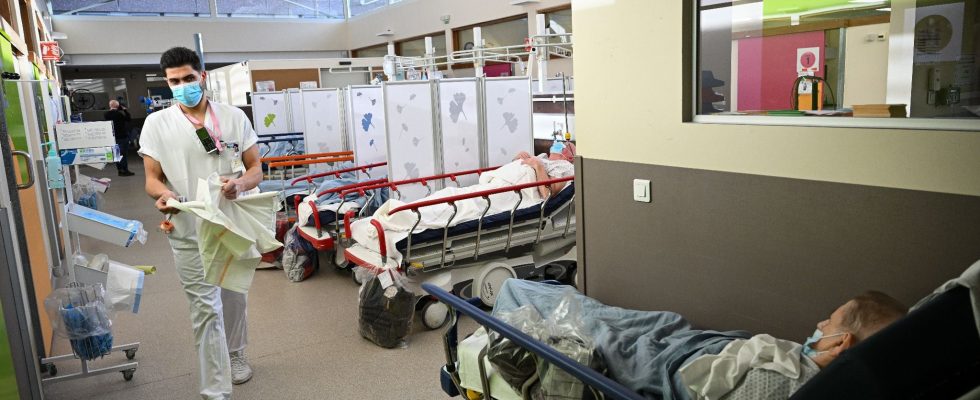The facts are stubborn but difficult to quantify due to a lack of reliable statistical data. The subject nevertheless increasingly worries hospital administrations, caregivers and especially patients and their families: serious adverse events linked to care (SAEs) – administrative understatement to speak of a death, or a complication, occurring the hospital and which should not have occurred – continue to include hospital emergencies in the “news” section of the newspapers. There is Lucas, 25, who died on the night of September 30 to October 1 in the emergency room of Hyères hospital after eight hours of waiting, victim of septic shock according to his family who filed a complaint for manslaughter. There is this 86-year-old woman found lifeless on January 2 on a stretcher in the emergency room of the Nantes University Hospital with a diagnosis of Covid and comorbidities. Josiane, 66, died of cardiac arrest on February 8 after ten hours of waiting in the emergency room of Eaubonne hospital (Val-d’Oise). And on February 14, this man who would have ended his life after, it is said, having spent… 10 days on a stretcher in the overcrowded psychiatric emergency room of the Purpan University Hospital in Toulouse.
What do these dramas have in common? Bereaved and angry families, an administration which hides behind “the ongoing administrative or criminal investigation” and the organization of the famous RMM (Morbidity and Mortality Review), these collective, retrospective analyzes of clinical cases for which is an AEIGAS occurred. The latest stigma of the emergency room congestion which is plaguing the public hospital: the new morbid accounting unit that is the “stretcher patient”. What is a patient or a stretcher bed, and what evil are they called?
To understand, it is useful to recall the rules which govern the flow of patients once past the emergency entrance airlock. The emergency reception services (SAU) are open to the city, 24 hours a day, without the possibility of regulating the incoming flow, of closing this tap whose flow is intensifying under the pressure of medical deserts, the scarcity of emergencies provided by private doctors and the aging of the population. The destiny of the patient who presents is to return home when possible or, if he must be hospitalized, to wait until a bed becomes available. For this to happen, a second tap must open, that of the downstream emergency services (internal medicine, geriatrics, infectious diseases, etc.). And so that a bed is freed up by a return home or a transfer to a “follow-up bed”, the downstream of the downstream therefore (follow-up care and rehabilitation service, Ephad, Samu social, etc.) -even bottled. This is the third tap.
A statement of failure
If the first is widely open, the other two are difficult to operate on a daily basis. The fault, among other things, of activity-based pricing (T2A) which sets the 100% bed occupancy rate as an efficiency marker – a corporate hospital management tool dating from 2009 which remains in force despite the promises and wishes of Emmanuel Macron. Also to blame for the 15 to 20% of beds closed due to lack of nurses, and the aging of the population. In my infectious diseases department, 87% of those arriving arrive through the emergency room. But on the transfer side, things get stuck. Record for 2023: 259 days of hospitalization for a patient who is too young, too demented, too precarious. Then bi-weekly meetings called “complex journeys” were added, another understatement for the analysis with the social teams, on a case-by-case basis, of the options for exiting what we call “bed bockers” among ourselves. .
“Stretcher beds” therefore refer to patients who have consulted emergency departments, whose medical treatment in the emergency room has ended and who are waiting, often in precarious conditions, for a bed to become available. They represent enormous daily stress in the tight flow of arrivals for emergency services. Even more, they constitute a loss of opportunity for the sick as well stretchered even placarded. A night spent on a stretcher increases the risk of mortality in elderly patients by 40% according to a recent study carried out by teams from AP-HP, Inserm and Sorbonne University. Thus the risk of dying for a patient over 75 years old admitted to the emergency room and who spends an entire night waiting for a bed in another department increases from 11.1% to 15.7%.
What does this growing phenomenon of stretcher beds represent on the ground? Let’s take a hospital on a human scale that is the one where I work (342 open beds): there were on February 16, at 7 a.m., out of 120 visits to the emergency room in the last 24 hours, 18 stretcher patients (on the 127 of the APHP) including 5 over 75 years old for an average waiting time for a bed of 12 hours. This is an acknowledgment of failure that is reflected in most hospitals, depending on the population base. As the president of Samu-Urgences de France, Doctor Marc Noizet, insists, among others: “We must declare the approval of emergencies a national hospital priority”. But for this we need a political will which cannot be reduced to the short term.
Professor Gilles Pialoux, infectious disease specialist at Tenon Hospital (APHP), vice-president of the French Society for the Fight against AIDS. Latest work published: An almost perfect gift, novel, Editions Mialet-Barrault (January 2024)
.
